Raptor HILIC-Si: Simplify the Switch to HILIC
- Retain polar compounds without ion-pairing reagents.
- 2.7 μm Raptor core-shell particles provide the speed of SPP.
- Ideal for increasing sensitivity and selectivity in LC-MS analyses.
- Fully compatible with both HPLC and UHPLC.
With Raptor LC columns, Restek chemists became the first to combine the speed of superficially porous particles (also known as SPP or “core-shell” particles) with the resolution of highly selective USLC technology. This new breed of chromatographic column allows you to more easily achieve peak separation and faster analysis times without expensive UHPLC instrumentation. Restek is extending the speed and reliability of Raptor to the HILIC realm with the addition of the Raptor HILIC-Si column.
Hydrophilic-interaction chromatography (HILIC) [1] is an increasingly popular alternative to reversed-phase LC for challenging polar analytes because it provides better retention of water-soluble compounds that are separated by polar differences (Figure 1). The Raptor HILIC-Si column simplifies the switch to HILIC because it delivers rugged Raptor performance, provides SPP column speed for faster analyses than traditional FPP silica columns, retains polar compounds without ion-pairing reagents, and is fully reliable, efficient, and selective with LC-MS compatible mobile phases.
1. A.J. Alpert, Hydrophilic-interaction chromatography for the separation of peptides, nucleic acids and other polar compounds, J. Chromatogr. 499 (1990) 177–196.
Column Description: |
|||
|
Recommended Usage:pH Range: 1.0–8.0 Properties:
Switch to a Raptor HILIC-Si LC column when:
|
||
Figure 1: Use HILIC when greater retention of polar analytes is needed. In HILIC mode, the aqueous mobile phase is the strong (or eluting) solvent versus the more familiar reversed-phase mode, where elution is the result of the organic solvent strength.
Raptor Technology Ensures Rugged, Reproducible Performance in the HILIC Realm
Raptor LC columns are well known for their rugged dependability, and the new Raptor HILIC-Si column brings the consistency of Raptor performance to HILIC. Lot to lot, column to column, and injection to injection, every Raptor HILIC-Si column gives a consistent performance that you can count on (Figures 2 and 3). Simplify your move to HILIC with the reliability of Raptor HILIC-Si columns.
Figure 2: Raptor HILIC-Si columns maintain efficiency at any dimension, even at operating pressures up to 575 bar so you can run at high linear velocities with confidence.
All testing performed using 2.7 μm Raptor HILIC-Si columns.
Figure 3: Strict quality control guarantees that rugged Raptor HILIC-Si columns provide reproducible results lot after lot and injection after injection.
Consistent Performance across Lots
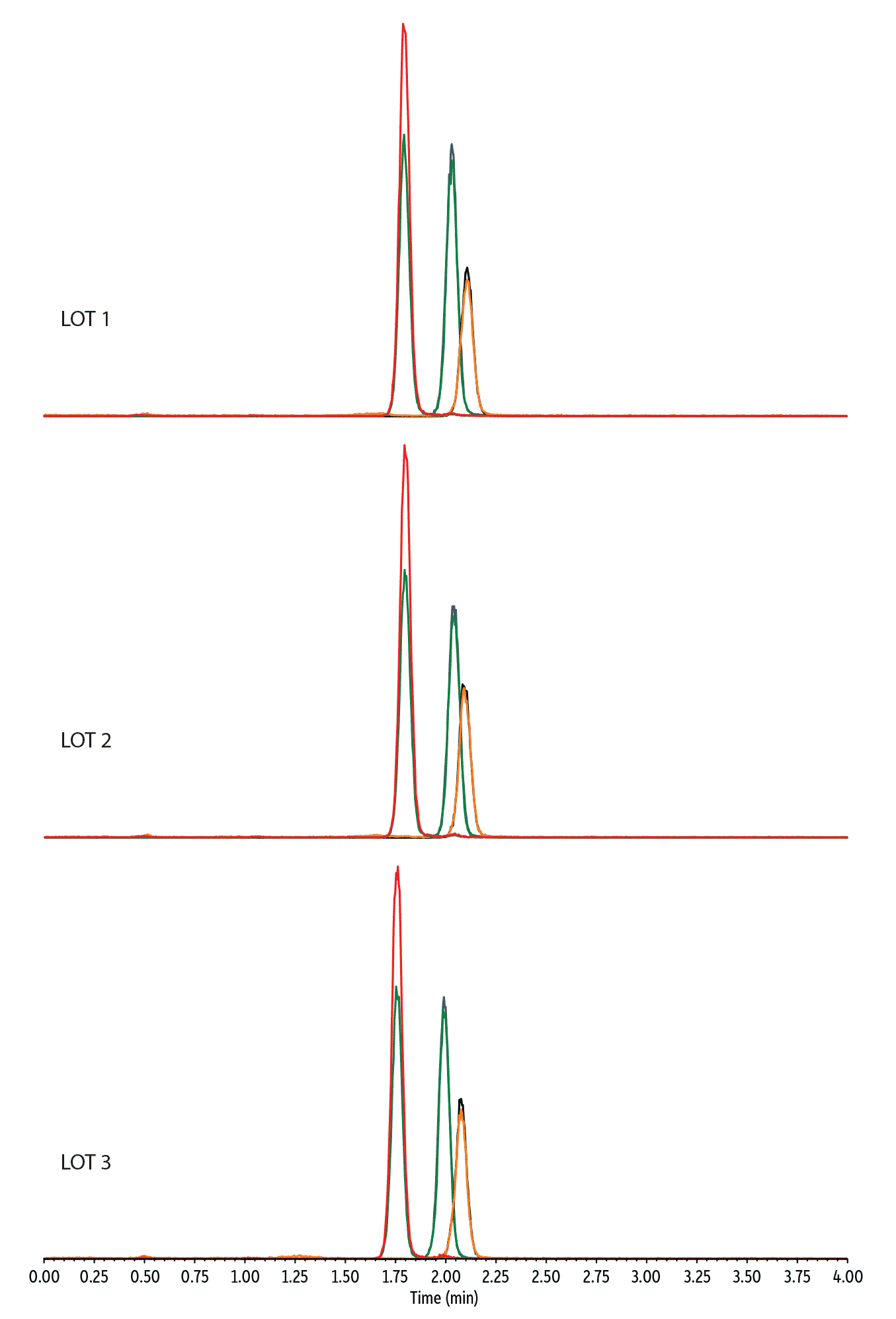
| Peaks | Conc. (ng/mL) | Precursor Ion | Product Ion | Product Ion | |
|---|---|---|---|---|---|
| 1. | 3-Methoxytyramine | 1 | 151.00 | 119.00 | 91.02 |
| 2. | Metanephrine | 1 | 179.94 | 148.22 | 165.01 |
| 3. | Normetanephrine | 1 | 166.00 | 134.02 | 121.01 |
| Column | Raptor HILIC-Si (cat.# 9310A52) | ||||||||||||
|---|---|---|---|---|---|---|---|---|---|---|---|---|---|
| Dimensions: | 50 mm x 2.1 mm ID | ||||||||||||
| Particle Size: | 2.7 µm | ||||||||||||
| Pore Size: | 90 Å | ||||||||||||
| Temp.: | 30 °C | ||||||||||||
| Standard/Sample | |||||||||||||
| Diluent: | Mobile phase A:mobile phase B (10:90) | ||||||||||||
| Conc.: | 1 ng/mL | ||||||||||||
| Inj. Vol.: | 10 µL | ||||||||||||
| Mobile Phase | |||||||||||||
| A: | Water, 100 mM ammonium formate, pH 3.0 | ||||||||||||
| B: | Acetonitrile | ||||||||||||
| |||||||||||||
| Max Pressure: | 80 bar |
| Detector | MS/MS |
|---|---|
| Ion Mode: | ESI+ |
| Mode: | MRM |
| Instrument | UHPLC |
Stable Results Injection after Injection

| Peaks | Conc. (ng/mL) | Precursor | Product Ion | Product Ion | 1st Injection (tR) | 135th Injection (tR) | |
|---|---|---|---|---|---|---|---|
| 1. | 3-Methoxytyramine | 1 | 151.00 | 119.00 | 91.02 | 1.80 | 1.83 |
| 2. | Metanephrine | 1 | 179.94 | 148.22 | 165.01 | 2.03 | 2.07 |
| 3. | Normetanephrine | 1 | 166.00 | 134.02 | 121.01 | 2.11 | 2.15 |
| Column | Raptor HILIC-Si (cat.# 9310A52) | ||||||||||||
|---|---|---|---|---|---|---|---|---|---|---|---|---|---|
| Dimensions: | 50 mm x 2.1 mm ID | ||||||||||||
| Particle Size: | 2.7 µm | ||||||||||||
| Pore Size: | 90 Å | ||||||||||||
| Temp.: | 30 °C | ||||||||||||
| Standard/Sample | |||||||||||||
| Diluent: | Mobile phase A:mobile phase B (10:90) | ||||||||||||
| Conc.: | 1 ng/mL | ||||||||||||
| Inj. Vol.: | 10 µL | ||||||||||||
| Mobile Phase | |||||||||||||
| A: | Water, 100 mM ammonium formate, pH 3.0 | ||||||||||||
| B: | Acetonitrile | ||||||||||||
|
| Detector | MS/MS |
|---|---|
| Ion Mode: | ESI+ |
| Mode: | MRM |
Raptor SPP + HILIC = More Speed, More Sensitivity
What makes Raptor HILIC-Si columns special? The answer is simple: you get the speed of a Raptor SPP column with the unique separating power of the HILIC retention mechanism. The benefits of superficially porous particles (SPP) are well known. SPP columns are characterized by a layer of porous silica bonded to a solid silica core, which gives faster, more efficient analyses. As shown in Figure 4, when you keep instrument parameters constant (flow, gradient, temperature) and compare a 3 μm fully porous particle (FPP) silica column to a 2.7 μm Raptor HILIC-Si SPP column, the benefits become clear. Raptor HILIC-Si columns combine faster analysis times with higher sensitivity so you can increase sample throughput and lower limits of quantification (LOQs) for difficult-to-retain polar analytes.
Figure 4: Raptor HILIC-Si columns provide the speed of SPP so you can analyze more samples per day.
The Raptor HILIC-Si Advantage
- 30% Decrease in elution time = increased sample throughput
- Elution in high % organic for efficient desolvation
- Narrower peaks = higher response, lower LOQs
- Excellent retention of difficult polar analytes
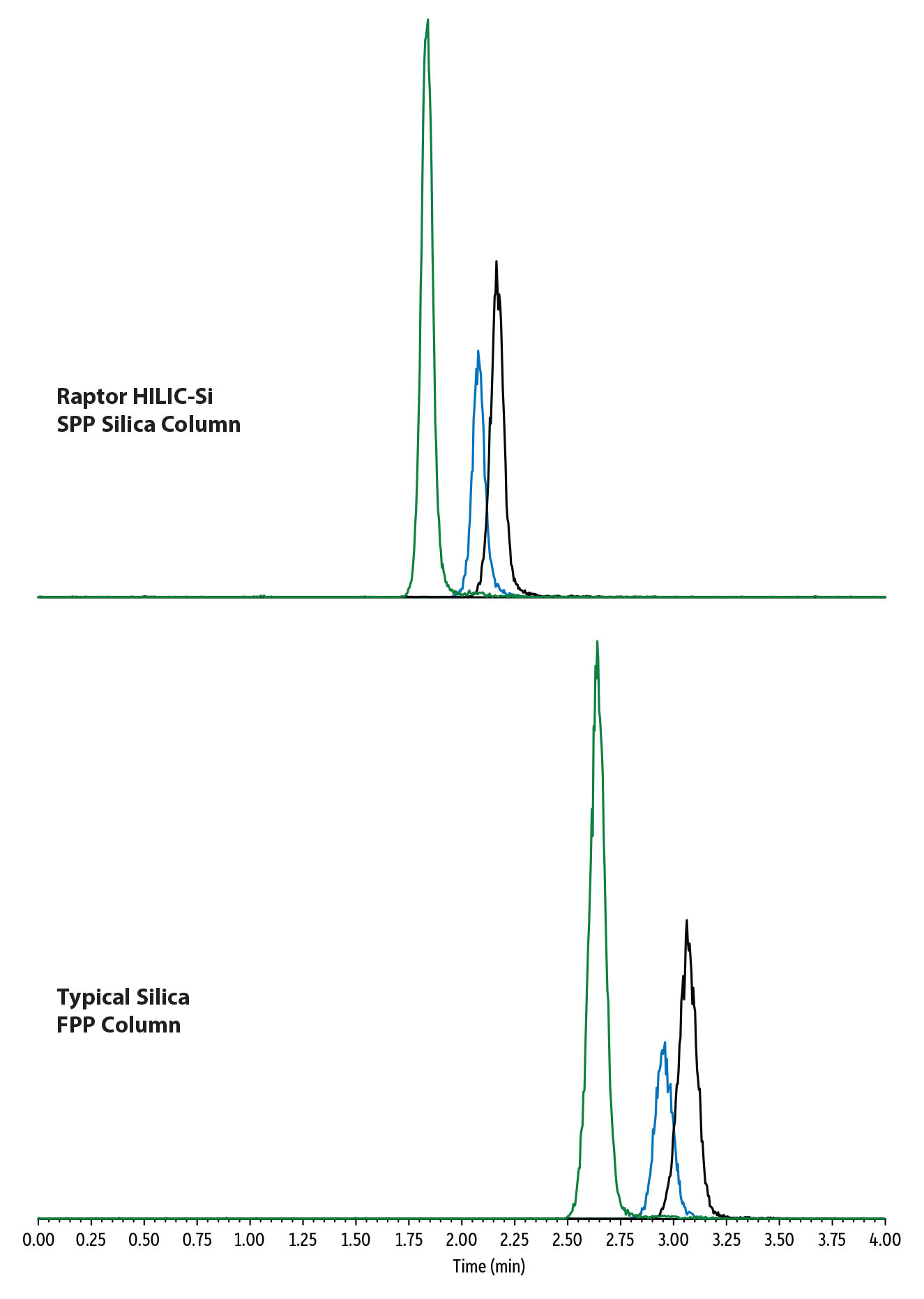
| Peaks | Conc. (ng/mL) | Precusor Ion | Product Ion | Raptor tR (min) | Typical FPP tR (min) | |
|---|---|---|---|---|---|---|
| 1. | 3-Methoxytyramine | 1 | 151.00 | 119.00 | 1.84 | 2.64 |
| 2. | Metanephrine | 1 | 179.94 | 148.22 | 2.08 | 2.96 |
| 3. | Normetanephrine | 1 | 166.00 | 134.02 | 2.16 | 3.06 |
| Column | Raptor HILIC-Si (cat.# 9310A52) | ||||||||||||
|---|---|---|---|---|---|---|---|---|---|---|---|---|---|
| Dimensions: | 50 mm x 2.1 mm ID | ||||||||||||
| Particle Size: | 2.7 µm | ||||||||||||
| Pore Size: | 90 Å | ||||||||||||
| Temp.: | 30 °C | ||||||||||||
| Standard/Sample | |||||||||||||
| Diluent: | Mobile phase A:mobile phase B (10:90) | ||||||||||||
| Conc.: | 1 ng/mL | ||||||||||||
| Inj. Vol.: | 10 µL | ||||||||||||
| Mobile Phase | |||||||||||||
| A: | Water, 100 mM ammonium formate, pH 3.0 | ||||||||||||
| B: | Acetonitrile | ||||||||||||
|
| Detector | MS/MS |
|---|---|
| Ion Mode: | ESI+ |
| Mode: | MRM |
| Instrument | UHPLC |
Raptor HILIC-Si Performance Gains vs. RP: Say Good-bye to Ion-Pairing Reagents
HILIC methods are becoming more common as analysts search for better solutions to challenging reversed-phase (RP) analyses. But, when is HILIC a beneficial alternative to a standard RP approach? HILIC should be considered when analyzing small polar compounds that are difficult to retain in RP mode without the use of ion-pairing reagents in the mobile phase. For example, paraquat and diquat are highly charged quaternary amine herbicides that are often analyzed in RP mode using ion-pairing reagents (Figure 5). But, these reagents can contaminate your LC-MS/MS and require the system be taken off-line frequently for extensive cleaning. With Raptor HILIC-Si columns, ion-pairing reagents are not needed and paraquat and diquat are quickly retained and resolved with MS-friendly solvents and buffers so your instrument stays up and running longer (Figure 6).
Figure 5: RP Analysis of Paraquat and Diquat with Ion-Pairing Mobile Phase Reagent
50 ng Injected

| Peaks | Precursor Ion (amu) | Fragment Ion (amu) | DP (V) | Collision Energy (eV) | |
|---|---|---|---|---|---|
| 1. | Diquat | 183 | 157 | 30 | 30 |
| 2. | Paraquat | 185 | 170 | 20 | 20 |
| Column | Fully Porous Reversed-Phase Quat Column |
|---|---|
| Dimensions: | 50 mm x 2.1 mm ID |
| Particle Size: | 3 µm |
| Pore Size: | 100 Å |
| Temp.: | ambient |
| Standard/Sample | |
| Diluent: | DI Water |
| Conc.: | 5 µg/mL each component |
| Inj. Vol.: | 10 µL |
| Mobile Phase | 10 mM heptafluorobutyric acid:acetonitrile (95:5) |
| Flow: | 0.3 mL/min |
| Detector | Applied Biosystems/MDS Sciex LC/MS/MS |
|---|---|
| Model #: | API 3200™ MS/MS system |
| Ion Source: | Electrospray |
| Ion Mode: | ESI+ |
| Ion Spray Voltage: | 5.5 kV |
| Curtain Gas: | 15 psi (103.4 kPa) |
| Gas 1: | 70 psi (482.6 kPa) |
| Gas 2: | 60 psi (413.7 kPa) |
| Source Temp.: | 600 °C |
| Mode: | MRM |
| Dwell Time: | 200 ms |
| Instrument | Applied Biosystems/MDS Sciex LC-MS/MS System |
| Notes | Collision exit potential: 3V Q1/Q3: unit resolution |
| Acknowledgement | Data courtesy of Houssain El Aribi, Ph.D., LC-MS Product and Application Specialist, MDS SCIEX, 71 Four Valley Drive, Concord, Ontario, Canada, L4K 4V8 |
Figure 6: Raptor HILIC-Si Analysis of Paraquat and Diquat with MS-Friendly Mobile Phases
0.25 ng Injected
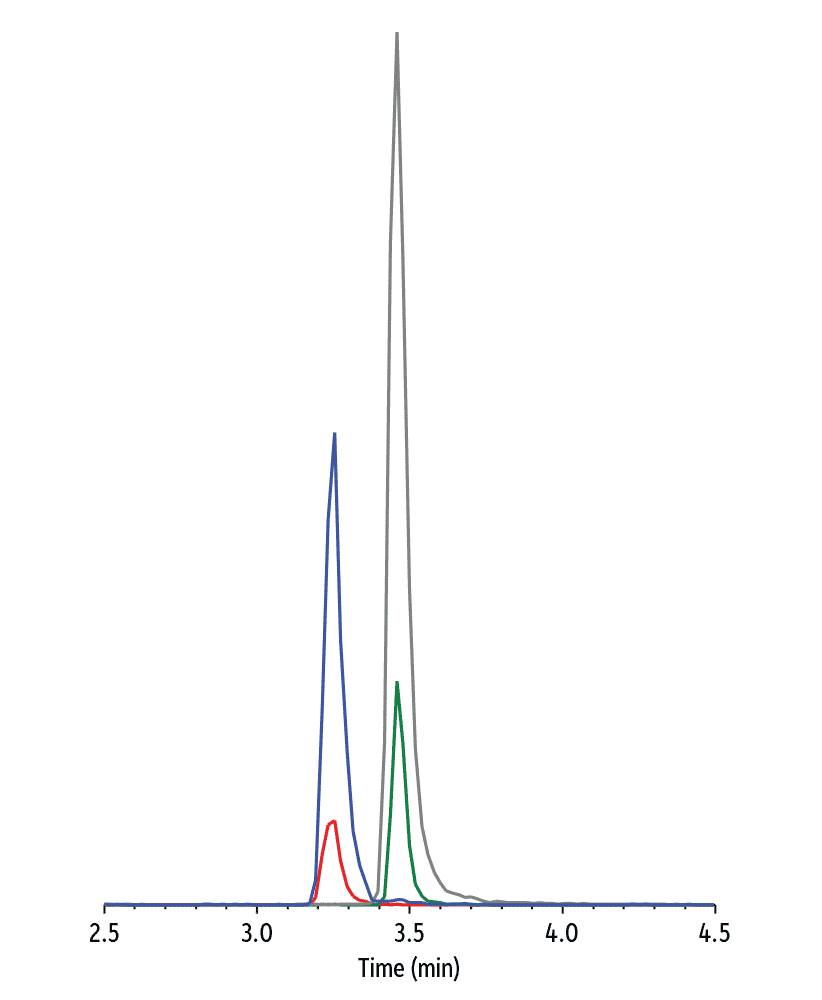
| Peaks | tR (min) | Precursor Ion 1 | Product Ion 1 | Precursor Ion 2 | Product Ion 2 | |
|---|---|---|---|---|---|---|
| 1. | Diquat | 3.25 | 183.3 | 157.2 | 183.3 | 130.1 |
| 2. | Paraquat | 3.46 | 185.3 | 170.3 | 171.3 | 77.2 |
| Column | Raptor HILIC-Si (cat.# 9310A52) | ||||||||||||||||||||
|---|---|---|---|---|---|---|---|---|---|---|---|---|---|---|---|---|---|---|---|---|---|
| Dimensions: | 50 mm x 2.1 mm ID | ||||||||||||||||||||
| Particle Size: | 2.7 µm | ||||||||||||||||||||
| Pore Size: | 90 Å | ||||||||||||||||||||
| Temp.: | 45 °C | ||||||||||||||||||||
| Standard/Sample | Paraquat & diquat calibration mix (cat.# 32437) | ||||||||||||||||||||
| Diluent: | Mobile phase B | ||||||||||||||||||||
| Conc.: | 50 ng/mL (cat.# 32437 diluted to 50 ng/mL in mobile phase B) | ||||||||||||||||||||
| Inj. Vol.: | 5 µL | ||||||||||||||||||||
| Mobile Phase | |||||||||||||||||||||
| A: | Water, 50 mM ammonium formate, 0.5% formic acid | ||||||||||||||||||||
| B: | 25:75 Water:acetonitrile, 50 mM ammonium formate, 0.5% formic acid | ||||||||||||||||||||
|
| Detector | MS/MS |
|---|---|
| Ion Mode: | ESI+ |
| Mode: | MRM |
| Instrument | HPLC |
Raptor HILIC-Si Improves the Performance of Your LC-MS/MS
One of the most striking ways that HILIC analyses differ from standard RP analyses is that in HILIC methods the aqueous mobile phase is the stronger solvent. It provides differential selectivity that helps retain small polar analytes until after the sample matrix has eluted. In addition, the higher concentration organic mobile phases used in HILIC methods improve solvent evaporation during electrospray ionization, leading to increased sensitivity for LC-MS/MS methods. The following applications illustrate the decrease in matrix interference and increase in LC-MS/MS sensitivity that can be obtained using HILIC conditions and a Raptor HILIC-Si column.
Folic Acid and Metabolites
Folate deficiency is considered a risk factor for a wide range of human health problems including neural tube defects in newborns, cardiovascular diseases, Alzheimer’s disease, and certain forms of cancer. The levels of folic acid and its metabolites in plasma are used as biomarkers to diagnose folate deficiency. However, when folic acid and its metabolites are extracted from plasma, phospholipids are also extracted and can cause matrix effects that make accurate quantitation difficult. Even with a good sample preparation protocol, 100% removal of phospholipids is difficult, and even at low levels they can interfere with the target analytes and also contaminate the MS source. By switching to a HILIC separation with a Raptor HILIC-Si column, you can quickly and easily separate the matrix components from the target analytes and accurately quantitate these important biomarkers for folate deficiency (Figure 7).
Figure 7: Folate Deficiency Biomarkers in Human Plasma
More resolution between analytes and matrix components lets you divert matrix to waste, which keeps your MS cleaner longer.
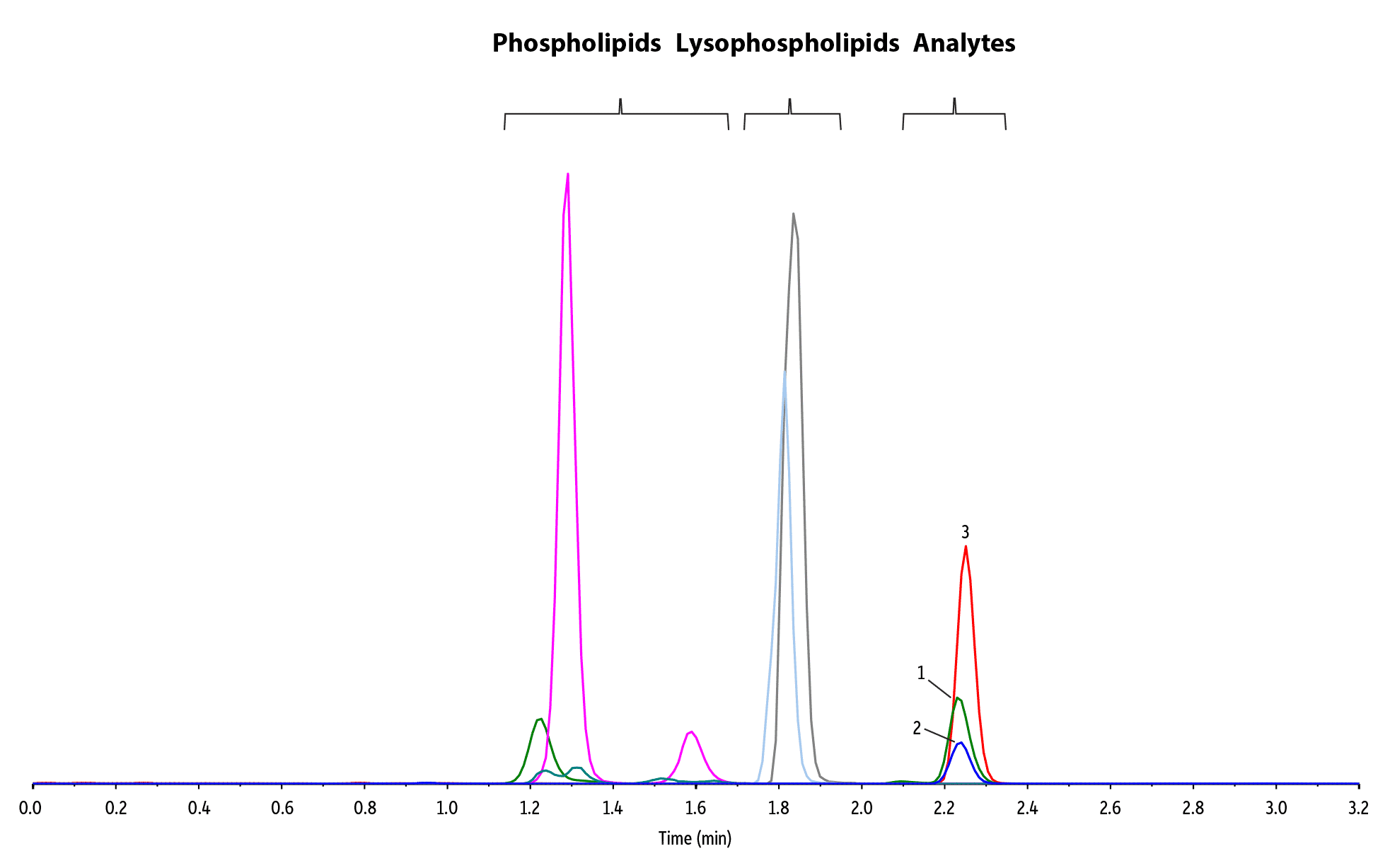
| Peaks | tR (min) | Conc. (ng/mL) | Precursor Ion | Product Ion | |
|---|---|---|---|---|---|
| 1. | 5-Formyl tetrahydrofolate | 2.23 | 50 | 474.2 | 327.0 |
| 2. | Folic acid | 2.23 | 25 | 442.2 | 295.0 |
| 3. | 5-Methyltetrahydrofolic acid | 2.25 | 25 | 460.3 | 313.0 |
| Column | Raptor HILIC-Si (cat.# 9310A5E) | ||||||||||||||||||
|---|---|---|---|---|---|---|---|---|---|---|---|---|---|---|---|---|---|---|---|
| Dimensions: | 50 mm x 3.0 mm ID | ||||||||||||||||||
| Particle Size: | 2.7 µm | ||||||||||||||||||
| Temp.: | 30 °C | ||||||||||||||||||
| Standard/Sample | |||||||||||||||||||
| Diluent: | 20 mM Ammonium acetate in acetonitrile:water (80:20) containing 10 mg/mL 2-mercaptoethanol | ||||||||||||||||||
| Inj. Vol.: | 5 µL | ||||||||||||||||||
| Mobile Phase | |||||||||||||||||||
| A: | 50:50 Water:acetonitrile, 20 mM ammonium acetate | ||||||||||||||||||
| B: | 20:80 Water:acetonitrile, 20 mM ammonium acetate | ||||||||||||||||||
| |||||||||||||||||||
| Max Pressure: | 344 bar |
| Detector | MS/MS |
|---|---|
| Ion Mode: | ESI+ |
| Mode: | MRM |
| Instrument | UHPLC |
| Sample Preparation | 1. Aliquot 380 μL of human plasma (K2EDTA, 2x charcoal stripped) containing 100 μg/mL 2-mercaptoethanol and add 20 μL fortification solution. 2. Vortex for 2 min and centrifuge for 2 min at 4000 rpm. 3. Condition EVOLUTE EXPRESS WAX 30 mg SPE plate (Biotage 604-0030-PX01) with 1 mL methanol and then equilibrate with 1 mL 2% formic acid in water. Apply vacuum to dry the plate completely. 4. Load 400 μL of sample onto the plate and apply vacuum to initiate the flow. 5. Wash the plate with 1 mL water. Apply vacuum to dry the plate completely. 6. Elute samples with 300 μL 5% ammonium hydroxide in methanol containing 10 mg/mL 2-mercaptoethanol. Apply vacuum for elution. 7. Evaporate extracts to dryness under nitrogen at 30 °C. 8. Reconstitute in 200 μL mobile phase B containing 10 mg/mL 2-mercaptoethanol. Note: The whole sample preparation process was performed under dim light. |
| Notes | Endogenous peaks for phospholipids and lysophospholipids are displayed because they are common matrix interferences and are known to suppress ionization efficiency. |
Monoamine Neurotransmitters and Metabolites
Measurements of monoamine neurotransmitters and their metabolites in plasma and urine are commonly used for clinical diagnosis and monitoring of neuroblastoma and pheochromocytoma. Quantifying free metanephrine and normetanephrine is the most sensitive and accurate test for this purpose, but analysis of these polar compounds using reversed-phase LC is problematic due to very limited retention and poor sensitivity. As shown in Figure 8, these polar metabolites can be adequately retained on a Raptor HILIC-Si column and detected at 50 pg/mL in human plasma, providing the sensitivity needed for clinical purposes (Figure 8).
Figure 8: Trace-Level Metanephrine, Normetanephrine, and 3-Methoxytyramine in Human Plasma
Even at 50 pg/mL, good signal-to-noise ratios mean lower LOQs and accurate results at trace levels.
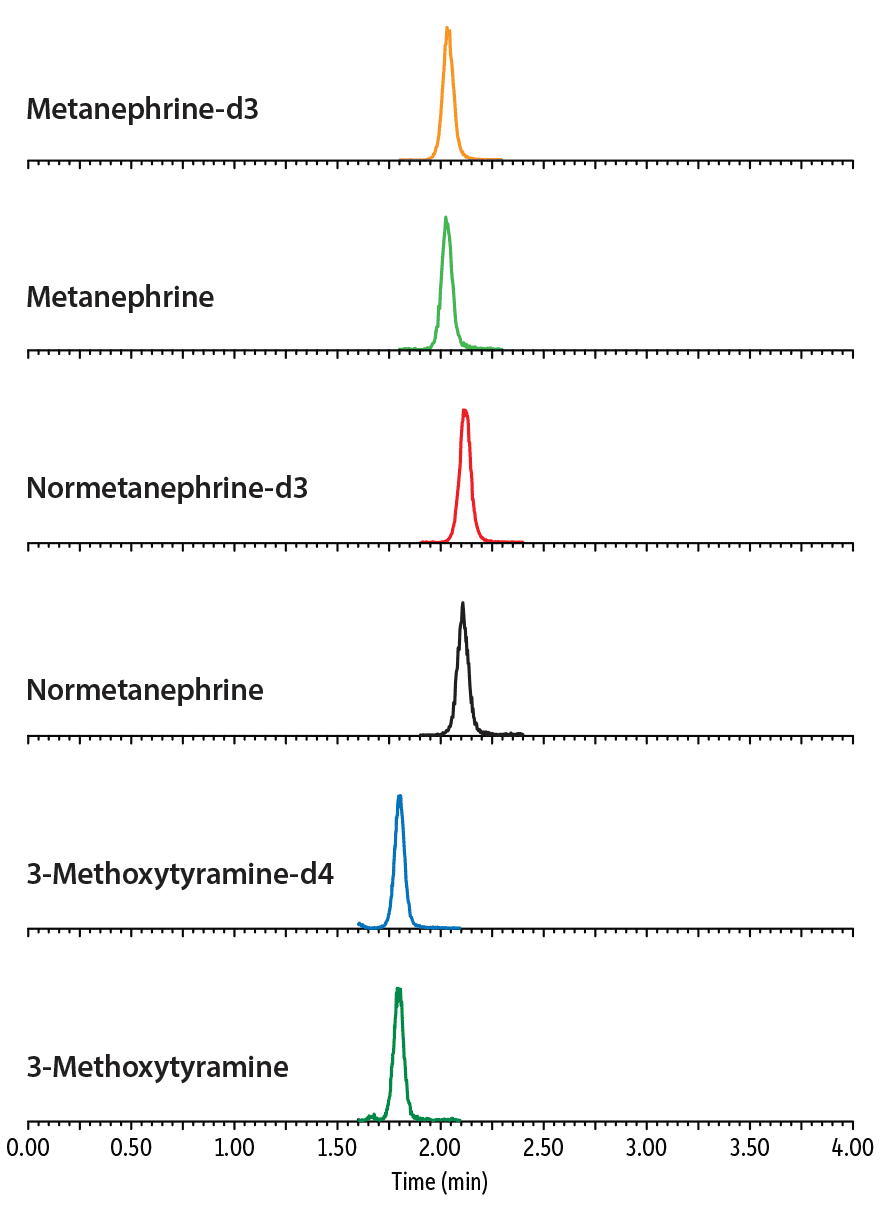
| Peaks | tR (min) | Conc. (pg/mL) | Precursor Ion | Product Ion | |
|---|---|---|---|---|---|
| 1. | 3-Methoxytyramine-d4 (IS) | 1.80 | 400 | 155.07 | 122.93 |
| 2. | 3-Methoxytyramine | 1.80 | 50 | 151.00 | 119.00 |
| 3. | Metanephrine-d3 (IS) | 2.03 | 200 | 183.00 | 151.15 |
| 4. | Metanephrine | 2.03 | 50 | 179.94 | 148.22 |
| 5. | Normetanephrine-d3 (IS) | 2.11 | 400 | 169.00 | 136.96 |
| 6. | Normetanephrine | 2.11 | 50 | 166.00 | 134.02 |
| Column | Raptor HILIC-Si (cat.# 9310A52) | ||||||||||||
|---|---|---|---|---|---|---|---|---|---|---|---|---|---|
| Dimensions: | 50 mm x 2.1 mm ID | ||||||||||||
| Particle Size: | 2.7 µm | ||||||||||||
| Pore Size: | 90 Å | ||||||||||||
| Temp.: | 30 °C | ||||||||||||
| Standard/Sample | |||||||||||||
| Diluent: | Mobile phase A:mobile phase B (10:90) | ||||||||||||
| Inj. Vol.: | 10 µL | ||||||||||||
| Mobile Phase | |||||||||||||
| A: | Water, 100 mM ammonium formate, pH 3.0 | ||||||||||||
| B: | Acetonitrile | ||||||||||||
|
| Detector | MS/MS |
|---|---|
| Ion Mode: | ESI+ |
| Mode: | MRM |
| Instrument | UHPLC |
| Sample Preparation | Charcoal stripped human plasma was fortified with analytes at 50 pg/mL (0.25, 0.27, and 0.30 nmol/L for metanephrine, normetanephrine, and 3-methoxytyramine, respectively). Internal standard (IS) was prepared at 4 ng/mL for metanephrine-d3 and at 8 ng/mL for normetanephrine-d3 and 3-methoxytyramine-d4 in methanol. The plasma sample (200 μL) was mixed with 10 μL of IS solution and 600 μL of 50 mM ammonium acetate solution. The mixture was loaded in an EVOLUTE EXPRESS WCX 96-well plate (30 mg) and washed with 1 mL water and 1 mL methanol:acetonitrile (50:50). The elution was performed twice with 0.9 mL of 5% formic acid in methanol:acetonitrile (50:50) and evaporated to dryness at 55 °C under a gentle stream of nitrogen. Dried extract was reconstituted with 100 μL of diluent and injected (10 μL) for analysis. |
Food Adulterants
Foods that contain a high protein content command a higher price, which can result in the illegal practice of food adulteration using nitrogen-rich compounds, such as melamine, to make the protein content appear higher than the actual value. Due to its potential for toxicity, testing for melamine and other structurally related compounds is required in many countries for foods, feed materials, and pharmaceutical components. The method shown in Figure 9 provides excellent retention of these highly polar analytes with a separation time of only 3.5 minutes and a complete cycle time of just 8 minutes using a Raptor HILIC-Si column.
Figure 9: Food Adulterants on Raptor HILIC-Si
The Raptor HILIC-Si column simplifies the analysis of difficult-to-retain polar analytes, such as melamine and related compounds.

| Peaks | tR (min) | Precursor Ion | Product Ion | Product Ion | Polarity | |
|---|---|---|---|---|---|---|
| 1. | Cyanuric acid | 0.47 | 127.8 | 84.9 | 42.1 | - |
| 2. | Cyromazine | 0.52 | 167.0 | 68.2 | 85.1 | + |
| 3. | Melamine | 0.89 | 127.2 | 85.0 | 68.3 | + |
| 4. | Ammelide | 2.18 | 129.1 | 86.1 | 70.2 | + |
| 5. | Ammeline | 2.97 | 128.2 | 86.2 | 69.1 | + |
| Column | Raptor HILIC-Si (cat.# 9310A52) | ||||||||||||||||||||||||
|---|---|---|---|---|---|---|---|---|---|---|---|---|---|---|---|---|---|---|---|---|---|---|---|---|---|
| Dimensions: | 50 mm x 2.1 mm ID | ||||||||||||||||||||||||
| Particle Size: | 2.7 µm | ||||||||||||||||||||||||
| Pore Size: | 90 Å | ||||||||||||||||||||||||
| Temp.: | 30 °C | ||||||||||||||||||||||||
| Standard/Sample | |||||||||||||||||||||||||
| Diluent: | 5:95 Water:acetonitrile, 10 mM ammonium formate, 0.1% formic acid | ||||||||||||||||||||||||
| Conc.: | 25 ng/mL | ||||||||||||||||||||||||
| Inj. Vol.: | 5 µL | ||||||||||||||||||||||||
| Mobile Phase | |||||||||||||||||||||||||
| A: | Water, 10 mM ammonium formate, 0.1% formic acid | ||||||||||||||||||||||||
| B: | 5:95 Water:acetonitrile, 10 mM ammonium formate, 0.1% formic acid | ||||||||||||||||||||||||
|
| Detector | MS/MS |
|---|---|
| Ion Mode: | ESI+/ESI- |
| Mode: | Scheduled MRM |
| Instrument | HPLC |
Where’s my 5 μm column?
Because HILIC methods use highly organic mobile phases, they generate very low backpressures. We’ve simplified your move to HILIC by offering the Raptor HILIC-Si column in a 2.7 μm particle size only. Our testing and applications development demonstrated that 2.7 μm columns offer higher efficiency than 5 μm columns, and they are compatible with any HPLC or UHPLC instrument you have in your lab.

